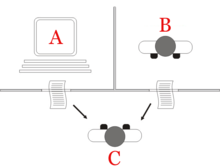The Turing Test is a concept introduced by British mathematician Alan Turing in 1950. It is a measure of a machine’s ability to exhibit intelligent behavior equivalent to, or indistinguishable from, that of a human. The test involves a human evaluator who engages in natural language conversations with another human and a machine designed to generate human-like responses. The evaluator knows that one of the two partners in conversation is a machine, and if the evaluator cannot reliably tell the machine from the human, the machine is said to have passed the test. While influential in the field of inteligência artificial[1], the Turing Test has been the subject of various debates and criticisms regarding its effectiveness and interpretation. Its applications and variations have been explored in AI research and tecnologia[2], with examples ranging from early programs like ELIZA and PARRY to modern chatbots and AI models.
O Teste de Turing, originally called the imitation game by Alan Turing in 1950, is a test of a machine's ability to exhibit intelligent behaviour equivalent to, or indistinguishable from, that of a human. Turing proposed that a human evaluator would judge natural language conversations between a human and a machine designed to generate human-like responses. The evaluator would be aware that one of the two partners in conversation was a machine, and all participants would be separated from one another. The conversation would be limited to a text-only channel, such as a computer keyboard and screen, so the result would not depend on the machine's ability to render words as speech. If the evaluator could not reliably tell the machine from the human, the machine would be said to have passed the test. The test results would not depend on the machine's ability to give correct answers to questions, only on how closely its answers resembled those a human would give. Since the Turing test is a test of indistinguishability in performance capacity, the verbal version generalizes naturally to all of human performance capacity, verbal as well as nonverbal (robotic).

The test was introduced by Turing in his 1950 paper "Computing Machinery and Intelligence" while working at the University of Manchester. It opens with the words: "I propose to consider the question, 'Can machines think?'" Because "thinking" is difficult to define, Turing chooses to "replace the question by another, which is closely related to it and is expressed in relatively unambiguous words." Turing describes the new form of the problem in terms of a three-person game called the "imitation game", in which an interrogator asks questions of a man and a woman in another room in order to determine the correct sex of the two players. Turing's new question is: "Are there imaginable digital computers which would do well in the imitation game?" This question, Turing believed, was one that could actually be answered. In the remainder of the paper, he argued against all the major objections to the proposition that "machines can think".
Since Turing introduced his test, it has been both highly influential and widely criticized, and has become an important concept in the philosophy of artificial intelligence. Philosopher John Searle would comment on the Turing test in his Chinese room argument, a thought experiment that stipulates that a machine cannot have a "mind", "understanding", or "consciousness", regardless of how intelligently or human-like the program may make the computer behave. Searle criticizes Turing's test and claims it is insufficient to detect the presence of consciousness. Searle goes on to dispute the notion that the mind (mental cognition) can exist outside of the body, a belief known as Cartesian dualism.